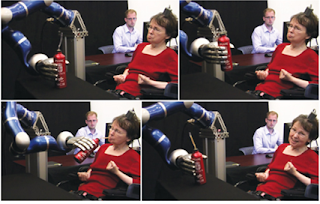 |
| Picture of a Lady using a Robotic Arm to Drink |
Working in Assistive Technology, we are always waiting for the next "killer APP", the technology that will come along and have a transformative effect on the lives of People with a Disability. For many years we've looked in hope to the emergent field of Robotics for that breakthrough.
Researchers working on the Braingate Project at Brown University in
Rhode Island, U.S.A., have successfully tested a Robotic Arm with a 58 year old
woman paralyzed in 1996, enabling her to lift a cup of coffee to her lips
independently for the first time since her accident. Lead researcher John Donoghue reported that "for the first time in 15 years, she was
doing something for herself”.
Previously the team at Brown
University had used similar technology to allow a paraplegic man to control a
mouse cursor on screen so as to use computer applications.
The technology currently
being tested depends on small sensors being implanted in a person’s brain,
these pick up signals from neurons in the motor cortex - the part of the brain
that governs movement. Through a series
of exercises the sensors pick up particular signals and in turn “teach” the
system which ones relate to particular movements.
Similar developments have
been seen in recent research in the related area of Brain Control Interfaces (BCI), where researchers have been achieving similar results
without the need for invasive sensors being implanted directly on a person’s
brain. Such non-invasive BCI’s tend to
use senors that a person can wear on their heads, these pick up brain signals
such as EEG (electro-encephalo-gram) signals which are similarly transferred
into movements for robotics, controlling a computer or other devices.
Donoghue says the results
are an important step towards assistive devices that can be controlled
directly. "You can imagine an arm like this mounted on a wheelchair,"
he says. Similarly, in the future we
could see such cutting edge ICT used to connect people with significant
disabilities with all of the potential that the internet has to offer.
See:
No comments:
Post a Comment